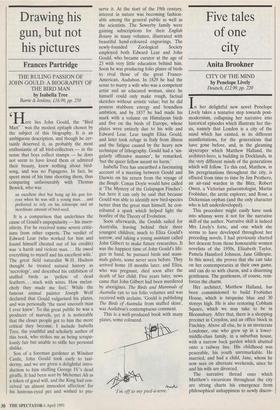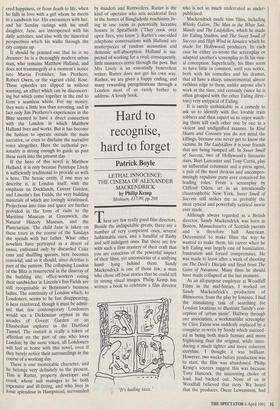Five tales of one city
Anita Brookner
CITY OF THE MIND by Penelope Lively Deutsch, £12.99, pp. 220 In her delightful new novel Penelope Lively takes a tentative step towards post- modernism, collapsing her narrative into historical episodes which illustrate her the- sis, namely that London is a city of the mind which has existed, in its different manifestations, for the generations that have gone before, and, in the gleaming skyscraper which Matthew Halland, the architect-hero, is building in Docklands, in the very different minds of the generations which will follow. To this end, Matthew, in his peregrinations throughout the city, is effaced from time to time by Jim Prothero, an air-raid warden in the Blitz, Robert Owen, a Victorian palaeontologist, Martin Frobisher, the arctic explorer, and Rose, a Dickensian orphan (and the only character who is left underdeveloped).
This procedure might easily have sunk into whimsy were it not for the narrative skill of the author. Narrative skill is indeed Mrs Lively's forte, and one which she seems to have developed throughout her preceding novels. I had previously charted her descent from those honourable women novelists of the 1950s, Elizabeth Taylor, Pamela Hansford Johnson, Jane Gillespie. In this novel, she proves that she can take on her contemporaries at their own game, and can do so with charm, and a disarming gentleness. The gentleness, of course, rein- forces the charm.
Her architect, Matthew Halland, has been commissioned to build Frobisher House, which is turquoise blue and 30 storeys high. He is also restoring Cobham Square, which we may take to be in Bloomsbury. After that, there is a shopping precinct in Croydon, and an office block in Finchley. Above all else, he is an inveterate Londoner, one who grew up in a lower- middle-class family, in a suburban house, with a narrow back garden which abutted onto a railway line. His childhood was peaceable, his youth unremarkable. He married, and had a child, Jane, whom he now sees on alternate weekends, since he and his wife are divorced.
The narrative thread onto which Matthew's excursions throughout the city are strung charts his emergence from philosophical unhappiness to newly discov- ered happiness, or from death to life, when he falls in love with a girl whom he meets in a sandwich bar. His encounters with her, and his Sunday outings with his small daughter, Jane, are interspersed with his daily activities, and also with the historical perspectives which his walks through the city conjure up.
It should be pointed out that he is no dreamer: he is a thoroughly modern urban man, who remains Matthew Halland, and does not transmogrify at a moment's notice into Martin Frobisher, Jim Prothero, Robert Owen, or the vagrant child, Rose. These episodes are slipped in without warning, an effect which can be disconcert- ing but which come together in the end to form a seamless whole. For my money, they were a little less than arresting, and in fact only Jim Prothero's experiences in the Blitz seemed to have a direct connection with the London in which Matthew Halland lives and works. But it has become the fashion to operate outside the main narrative, or even to disclaim the narrative voice altogether. Here the authorial per- sonality is strong enough to guide us past these reefs into the present day.
If the hero of this novel is Matthew Halland, it is only because Penelope Lively is sufficiently traditional to provide us with a hero. The heroic entity, if one may so describe it, is London itself, with the emphasis on Docklands, Covent Garden, and Lincoln's Inn Fields, the very building materials of which are lovingly scrutinised. Projections into time and space are further provided in the form of visits to the Maritime Museum at Greenwich, the Natural History Museum, and the Planetarium. The child Jane is taken on these tours in the course of the Sundays she spends with her father. What other novelists have portrayed as a desert of ennui, enlivened only by discarded Coke cans and shuffling queues, here becomes convivial, and so it should, since detritus is part of the pattern. The collapsing London of the Blitz is resurrected in the disarray of the building site; office-workers eating their sandwiches in Lincoln's Inn Fields are still recognisable as Betjeman's business ladies. The continuity of London which, to Londoners, seems to be fast disappearing, is here reinforced, though it must be admit- ted that few contemporary Londoners would see a Dickensian orphan in the arcades of Covent Garden or an Elizabethan explorer in the Dartford Tunnel. The conceit is really a token of affection on the part of one who loves London; by the same token, all Londoners will feel at home with this novel, even it they barely notice their surroundings in the course of a working day. There is one memorable character, and he belongs very definitely to the present. This is Rutter, property developer and crook, whose suit manages to be both expensive and ill-fitting, and who lives in Ionic splendour in Hampstead, surrounded by minders and Rottweilers. Rutter is the kind of operator who sets accidental fires in the homes of Bangladeshi machinists liv- ing in one room in potentially lucrative houses in Spitalfields (`They cook over open fires, you know'). Rutter's one-sided telephone conversations with Halland are masterpieces of random accusation and demonic self-absorption. Halland is sus- pected of working for a rival; consequently, little nuisances arrive through the post. But Mrs Lively is an essentially benevolent writer: Rutter does not get his own way. Rather, we are given a happy ending, and many rewarding peregrinations through a London most of us rarely bother to address. A lovely book.



















































 Previous page
Previous page